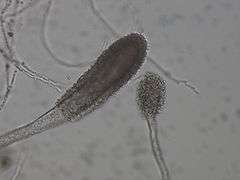Aspergillus clavatus
| Aspergillus clavatus | |
|---|---|
 | |
| Conidial head of Aspergillus clavatus | |
| Scientific classification | |
| Kingdom: | Fungi |
| Division: | Ascomycota |
| Class: | Eurotiomycetes |
| Order: | Eurotiales |
| Family: | Trichocomaceae |
| Genus: | Aspergillus |
| Species: | A. clavatus |
| Binomial name | |
| Aspergillus clavatus Desm. (1834) | |
| Synonyms[1] | |
| |
Aspergillus clavatus is a species of Aspergillus with conidia dimensions 3–4.5 x 2.5–4.5 μms. It is found in soil and animal manure. The fungus was first described scientifically in 1834 by the French mycologist John Baptiste Henri Joseph Desmazières.[2]
The fungus can produce the toxin patulin, which may be associated with disease in humans and animals. This species is only occasionally pathogenic.
Other sources have identified many species of Aspergillus as producing dry, hydrophobic spores that are easily inhaled by humans and animals. Due to the small size of the spores, about 70% of spores of A. fumigatus are able to penetrate into the trachea and primary bronchi and close to 1% into alveoli. Inhalation of spores of Aspergillus is a health risk. A. clavatus is allergenic, causing the occupational hypersensitivity pneumonitis known as malt-worker's lung.
References
- ↑ "GSD Species Synonymy: Aspergillus clavatus Desm.". Species Fungorum. CAB International. Retrieved 2014-10-12.
- ↑ Desmazières JBHJ. (1834). "Descriptions et figures de six hyphomycètes inédites à ajouter à la flore Française". Annales des Sciences Naturelles, Botanique (in French). 2 (2): 69–73.